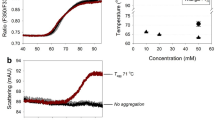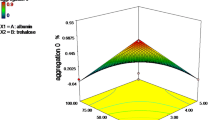Abstract
Complexes formed between poly(acrylates) and polyclonal immunoglobulin G (IgG) in its native conformation and after heat stress were characterized using asymmetric flow field-flow fractionation (AF4) coupled with on-line UV-Vis spectroscopy and multi-angle light-scattering detection (MALS). Mixtures of IgG and poly(acrylates) of increasing structural complexity, sodium poly(acrylate) (PAA), a sodium poly(acrylate) bearing at random 3 mol % n-octadecyl groups, and a random copolymer of sodium acrylate (35 mol %), N-n-octylacrylamide (25 mol %) and N-isopropylacrylamide (40 mol %), were fractionated in a sodium phosphate buffer (0.02 M, pH 6.8) in the presence, or not, of 0.1 M NaCl. The AF4 protocol developed allowed the fractionation of solutions containing free poly(acrylates), native IgG monomer and dimer, poly(acrylates)/IgG complexes made up of one IgG molecule and a few polymer chains, and/or larger poly(acrylates)/IgG aggregates. The molar mass and recovery of the soluble analytes were obtained for mixed solutions of poly(acrylates) and native IgG and for the same solutions incubated at 65 °C for 10 min. From the combined AF4 results, we concluded that in solutions of low ionic strength, the presence of PAA increased the recovery ratio of IgG after thermal stress because of the formation of electrostatically-driven PAA/IgG complexes, but PAA had no protective effect in the presence of 0.1 M NaCl. Poly(acrylates) bearing hydrophobic groups significantly increased IgG recovery after stress, independently of NaCl concentration, because of the synergistic effect of hydrophobic and electrostatic interactions. The AF4 results corroborate conclusions drawn from a previous study combining four analytical techniques. This study demonstrates that AF4 is an efficient tool for the analysis of protein formulations subjected to stress, an important achievement given the anticipated important role of proteins in near-future human therapies.
ᅟ





Similar content being viewed by others
Notes
Communication with the supplier indicates that the short fragments are not removed readily from the IgG monomer.
References
Bucciantini M, Giannoni E, Chiti F, Baroni F, Formigli L, Zurdo JS, Taddei N, Ramponi G, Dobson CM, Stefani M (2002) Inherent toxicity of aggregates implies a common mechanism for protein misfolding diseases. Nature 416(6880):507–511
Roberts CJ (2007) Non-native protein aggregation kinetics. Biotechnol Bioeng 98(5):927–938
Wang W, Nema S, Teagarden D (2010) Protein aggregation pathways and influencing factors. Int J Pharm 390(2):89–99
Philo JS (2006) Is any measurement method optimal for all aggregate sizes and types? AAPS J 8(3):E564–E571
Litzen A, Walter JK, Krischollek H, Wahlund KG (1993) Separation and quantitation of monoclonal-antibody aggregates by asymmetrical flow field-flow fractionation and comparison to gel-permeation chromatography. Anal Biochem 212(2):469–480
Wahlund KG (2013) Flow field-flow fractionation: critical overview. J Chromatogr A 1287:97–112
Ma PL, Buschmann MD, Winnik FM (2010) Complete physicochemical characterization of DNA/chitosan complexes by multiple detection using asymmetrical flow field-flow fractionation. Anal Chem 82(23):9636–9643
Heroult J, Nischwitz V, Bartczak D, Goenaga-Infante H (2014) The potential of asymmetric flow field-flow fractionation hyphenated to multiple detectors for the quantification and size estimation of silica nanoparticles in a food matrix. Anal Bioanal Chem 406(16):3919–3927
Pasch H, Makan A, Chirowodza H, Ngaza N, Hiller W (2014) Analysis of complex polymers by multidetector field-flow fractionation. Anal Bioanal Chem 406(6):1585–1596
Hawe A, Romeijn S, Filipe V, Jiskoot W (2012) Asymmetrical flow field-flow fractionation method for the analysis of submicron protein aggregates. J Pharm Sci 101(11):4129–4139
Runyon JR, Nilsson L, Alftren J, Bergenstahl B (2013) Characterization of oat proteins and aggregates using asymmetric flow field-flow fractionation. Anal Bioanal Chem 405(21):6649–6655
Reschiglian P, Roda B, Zattoni A, Tanase M, Marassi V, Serani S (2014) Hollow-fiber flow field-flow fractionation with multi-angle laser scattering detection for aggregation studies of therapeutic proteins. Anal Bioanal Chem 406(6):1619–1627
Qureshi RN, Kok WT (2011) Application of flow field-flow fractionation for the characterization of macromolecules of biological interest: a review. Anal Bioanal Chem 399(4):1401–1411
Yohannes G, Jussila M, Hartonen K, Riekkola ML (2011) Asymmetrical flow field-flow fractionation technique for separation and characterization of biopolymers and bioparticles. J Chromatogr A 1218(27):4104–4116
Weiss WF, Young TM, Roberts CJ (2009) Principles, approaches, and challenges for predicting protein aggregation rates and shelf life. J Pharm Sci 98(4):1246–1277
Martin N, Ma DW, Herbet A, Boquet D, Winnik FM, Tribet C (2014) Prevention of thermally induced aggregation of igg antibodies by noncovalent interaction with poly(acrylate) derivatives. Biomacromolecules 15(8):2952–2962
Borrega R, Tribet C, Audebert R (1999) Reversible gelation in hydrophobic polyelectrolyte/protein mixtures: an example of cross-links between soft and hard colloids. Macromolecules 32(23):7798–7806
Hawe A, Friess W, Sutter M, Jiskoot W (2008) Online fluorescent dye detection method for the characterization of immunoglobulin g aggregation by size exclusion chromatography and asymmetrical flow field flow fractionation. Anal Biochem 378(2):115–122
Zimm BH (1948) The scattering of light and the radial distribution function of high polymer solutions. J Chem Phys 16(12):1093–1099
Johnstone A, Thorpe R (1987) Immunochemistry in practice, 2nd edn. Blackwell Scientific Publication, Oxford
Schachermeyer S, Ashby J, Kwon M, Zhong WW (2012) Impact of carrier fluid composition on recovery of nanoparticles and proteins in flow field flow fractionation. J Chromatogr A 1264:72–79
Ma DW, Martin N, Herbet A, Boquet D, Tribet C, Winnik FM (2012) The thermally induced aggregation of immunoglobulin G in solution is prevented by amphipols. Chem Lett 41(10):1380–1382
Acknowledgments
This work was supported by the Natural Sciences and Engineering Research Council of Canada (Collaborative Strategic Program) and by the Agence Nationale pour la Recherche (program Blanc International, grant INT 1501 and program Investissement d’Avenir ANR-11-LABX-0011-01). F.M.W. also acknowledges financial support from the World Premier International Research Center Initiative (MPI) MEXT Japan.
Author information
Authors and Affiliations
Corresponding author
Electronic supplementary material
Below is the link to the electronic supplementary material.
ESM 1
(PDF 46 kb)
Rights and permissions
About this article
Cite this article
Ma, D., Martin, N., Tribet, C. et al. Quantitative characterization by asymmetrical flow field-flow fractionation of IgG thermal aggregation with and without polymer protective agents. Anal Bioanal Chem 406, 7539–7547 (2014). https://doi.org/10.1007/s00216-014-8200-2
Received:
Revised:
Accepted:
Published:
Issue Date:
DOI: https://doi.org/10.1007/s00216-014-8200-2




